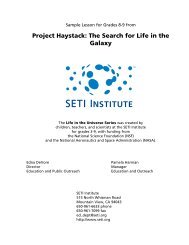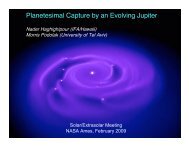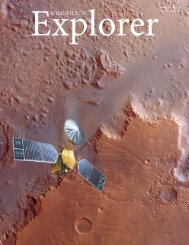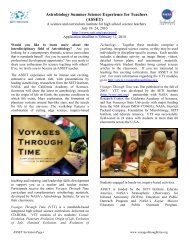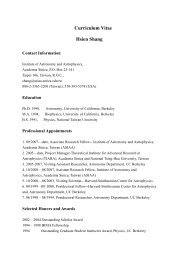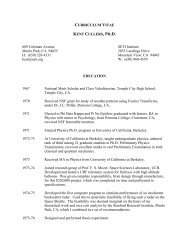Inside the Boardroom with Alan Bagley - SETI Institute
Inside the Boardroom with Alan Bagley - SETI Institute
Inside the Boardroom with Alan Bagley - SETI Institute
You also want an ePaper? Increase the reach of your titles
YUMPU automatically turns print PDFs into web optimized ePapers that Google loves.
Astrobiology<br />
Artist’s concept of an asteroid striking<br />
near an inhabited region.<br />
© David A. Hardy/ www.astroart.org<br />
Planetary Defense in Space<br />
by Claudio Maccone<br />
Saving <strong>the</strong> Earth from collision<br />
<strong>with</strong> asteroids and comets is <strong>the</strong><br />
number one imperative for all<br />
those who care about <strong>the</strong> survival<br />
of humankind. Unfortunately, this<br />
deadly threat was not clearly perceived until<br />
1980, when <strong>the</strong> American Nobel laureate<br />
Louis Alvarez suggested that <strong>the</strong> dinosaurs<br />
were wiped out by <strong>the</strong> collision of a ~20 km<br />
asteroid about 65 million years ago.<br />
Ever since, a few scientists of good will<br />
have tried to convince <strong>the</strong>ir governments<br />
that something must be done (<strong>the</strong> set of all<br />
such actions is called “planetary defense”),<br />
but <strong>with</strong>out any significant success so far.<br />
Apart from <strong>the</strong> obvious lack of funding, <strong>the</strong><br />
problem of how to divert an asteroid threat<br />
is so difficult to tackle that even <strong>the</strong> scientists<br />
don’t know exactly what to do, let alone<br />
<strong>the</strong> managers of <strong>the</strong> national space agencies<br />
and <strong>the</strong> various military establishments.<br />
Also, movies like “Armageddon” and<br />
“Deep Impact” have dramatized <strong>the</strong> story,<br />
but <strong>the</strong> solutions <strong>the</strong>y portrayed are simply<br />
impossible because no Shuttle would be capable<br />
of reaching so far into space, and <strong>with</strong><br />
such short notice.<br />
In 2002, this author put forward a new<br />
idea: orchestrate planetary defense from<br />
outposts in space, ra<strong>the</strong>r than sit and wait<br />
on <strong>the</strong> Earth. This would give us at least<br />
a bit more time (days) to try to divert asteroids<br />
by shooting missiles against <strong>the</strong>m<br />
from two space bases, best located at <strong>the</strong><br />
Lagrangian points L1 and L3 of <strong>the</strong> Earth-<br />
Moon system. The author showed that:<br />
(1) This defense system would be ideal for<br />
deflecting small impactors, less than<br />
1 km in diameter. These are <strong>the</strong> most<br />
difficult ones to detect far in advance,<br />
and <strong>with</strong> sufficient orbital accuracy.<br />
(2) The deflection is achieved by pure<br />
lateral push (momentum transfer).<br />
No nuclear weapons in space would<br />
be needed. This is because <strong>the</strong> missiles<br />
are hitting <strong>the</strong> impactor at <strong>the</strong><br />
optimal angle of 90° from <strong>the</strong>ir arrival<br />
direction.<br />
(3) In case one missile was not enough to<br />
deflect <strong>the</strong> impactor off its collision<br />
trajectory, <strong>the</strong> new, slightly-deflected<br />
impactor can be hit at 90° by ano<strong>the</strong>r<br />
missile. So, a sufficient number<br />
of missiles could be launched in a<br />
sequence from L1 and L3 to finally<br />
throw <strong>the</strong> impactor off its collision<br />
trajectory <strong>with</strong> Earth.<br />
The Five Earth-Moon<br />
Lagrangian Points<br />
In 1772, Joseph Louis Lagrange demonstrated<br />
that <strong>the</strong>re are five positions of zero<br />
gravity in a rotating two-body system, like<br />
<strong>the</strong> Moon around <strong>the</strong> Earth.<br />
Three are located on <strong>the</strong> line joining<br />
<strong>the</strong> two massive bodies, and are nowadays<br />
called “colinear points,” or L1, L2 and L3,<br />
as shown in Figure A. Two more points<br />
(L4 and L5) form equilateral triangles <strong>with</strong><br />
<strong>the</strong> two massive bodies, and so are called<br />
“triangular points.” The distance to L1<br />
is about 32,300 km, and to L3 is roughly<br />
382,000 km.<br />
10<br />
<strong>SETI</strong> <strong>Institute</strong> Explorer




